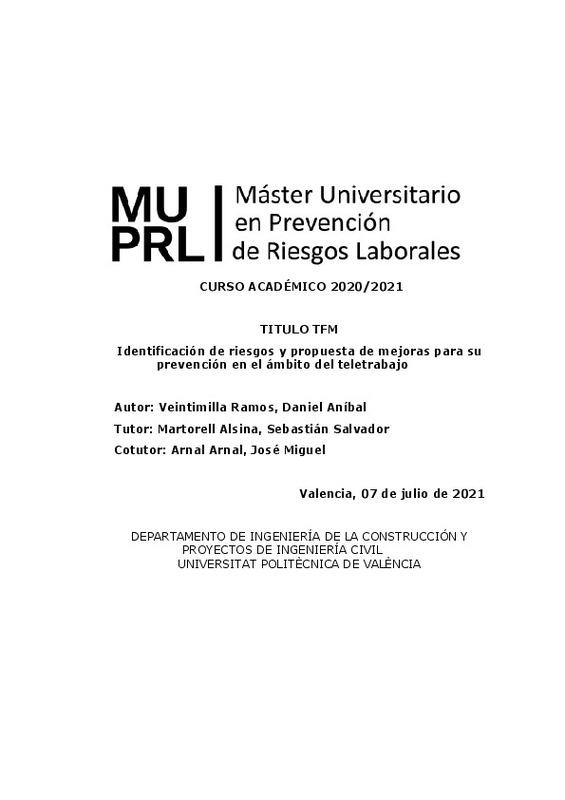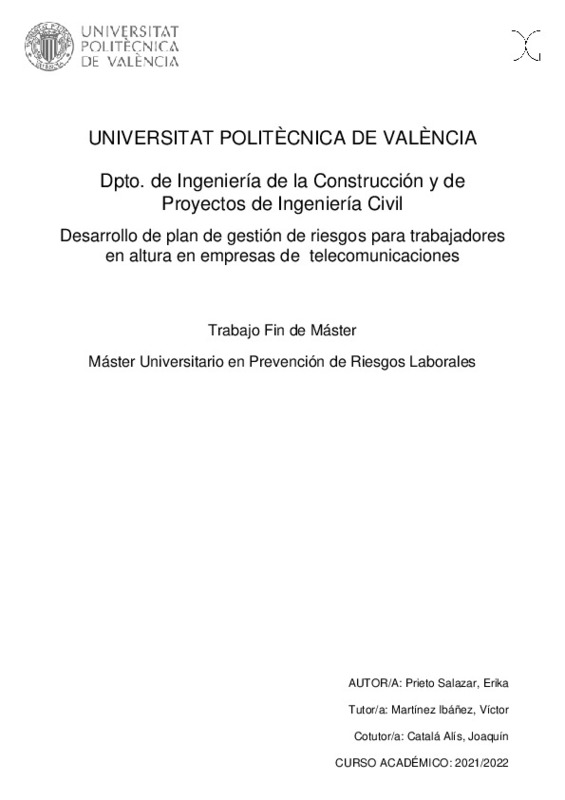|
Resumen:
|
[ES] Como consecuencia de la realidad que vivimos debido a la Covid-19, la sociedad, se ha adaptado a las nuevas exigencias derivadas del confinamiento. En el ámbito laboral, cuando ha sido posible, recurriendo al teletrabajo ...[+]
[ES] Como consecuencia de la realidad que vivimos debido a la Covid-19, la sociedad, se ha adaptado a las nuevas exigencias derivadas del confinamiento. En el ámbito laboral, cuando ha sido posible, recurriendo al teletrabajo (instaurado en nuestros hogares de forma abrupta y forzada, sin ninguna previsión), lo que nos ha llevado a plantearnos la necesidad de adecuar el espacio de trabajo y la mentalidad a nuevos horizontes.
Plantear el estudio del teletrabajo requiere de un doble esfuerzo, tanto porque no es una realidad totalmente establecida que permitan una amplia comparativa a nivel nacional, como porque el marco legal hasta la fecha actual es escaso (Acuerdo Marco Europeo sobre el teletrabajo, el RD Ley 3/2012, y el recientemente aprobado RD Ley 28/2020. La incorporación en algunas de las universidades españolas del teletrabajo, como subespecie del trabajo no presencial desde 2010. Incluyendo el estudio de la NTP 412 buenas prácticas en el teletrabajo, el RD 488/97, del 14 de abril, y sus respectivas directivas en el ámbito comunitario sobre seguridad y salud (89/391/CEE), en pantallas de visualización (90/270/CEE).
Dado que algunos de los factores de riesgo asociados con el teletrabajo ya cuentan con medidas preventivas; nos basaremos en la posibilidad de que aparezcan nuevos factores que requerirán de un esfuerzo mayor de investigación con el fin de encontrar nuevas soluciones para su prevención.
El estudio relativo a los riesgos psicosociales: en relación a su vida personal (conciliación y transversalidad de género, el derecho a la desconexión laboral, la sobrecarga de trabajo, el aislamiento, la posibilidad de que surjan nuevos tipos de liderazgo que impliquen modificaciones organizacionales, ansiedad, inseguridad¿ entre otros; en relación a los riesgos ergonómicos, la deficiencia en el acondicionamiento de los espacios de trabajo, de mobiliario apropiado, en la correcta iluminación, la temperatura.
Incluir, como parte de este estudio los sectores afectados por esta modalidad de trabajo a consecuencia del SARS-Cov2 durante el estado de alarma, y si les son de aplicación las medidas preventivas.
El estudio del teletrabajo, desde la perspectiva analítica, para determinar la existencia de nuevos riesgos y, si los hubiese, la necesidad de determinar un plan de riesgos laborales que se adecuase a las nuevas exigencias que pudiesen derivarse. Desde una perspectiva práctica, es necesario focalizar el estudio en el análisis empresas y actividades que han optado mayoritariamente por el teletrabajo, tanto con anterioridad como a consecuencia de la pandemia, con el fin de ver su evolución, gestión y adaptación (resulta conveniente el estudio de los informes a resultas de los Proyectos Pilotos sobre Teletrabajo en los que participaron algunas de nuestras universidades (USAL, UA, US, UAB...).
[-]
[EN] As a consequence of the reality that we live due to Covid-19, society has adapted to the new demands derived from confinement. In the workplace, when possible, resorting to teleworking (established in our homes, in ...[+]
[EN] As a consequence of the reality that we live due to Covid-19, society has adapted to the new demands derived from confinement. In the workplace, when possible, resorting to teleworking (established in our homes, in an abrupt and forced way, without any foresight), which has led us to consider the need to adapt the workspace and mentality to new horizons .
Raising the study of telework requires a double effort, both because it is not a fully established reality that allows a broad comparison at the national level, and because the legal framework to date is scarce (European Framework Agreement on telework, the RD Law 3/2012, and the recently approved RD Law 28/2020. The incorporation in some of the Spanish universities of telework, as a subspecies of non-face-to-face work since 2010. Including the study of the NTP 412 good practices in telework, RD 488 / 97, of April 14, and their respective directives at the community level on health and safety (89/391 / CEE), on display screens (90/270 / CEE).
Given that some risk factors associated with telework already have preventive measures, we will rely on the possibility that new factors appearing, which require a greater research effort to find new solutions for their prevention.
The study concerning the psychosocial risks: according their ways to live (conciliation and gender mainstreaming, the right to disconnect from work, work overload, isolation, the possibility of new types of leadership arising that imply organizational modifications, anxiety, insecurity... among others), concerning the ergonomic risks, the deficiency in the conditioning of the work spaces, the appropriate furniture, the correct lighting, the temperature.
Include, as part of this study, the sectors affected by this work modality as a result of SARS-Cov2 during the state of alarm, and if preventive measures are applicable to them.
The study of telework, from an analytical perspective, to determine the existence of new risks and, if any, the need to determine an occupational risk plan that is adapted to the new demands that may arise. From a practical perspective, it is necessary to focus efforts and study in the the analysis of companies and activities that have mostly opted for teleworking, before or as a result of the pandemic, in order to see its evolution, management and adaptation (The study is convenient of the reports as a result of the Pilot Projects on Telework in which some of our universities:USAL, UA, US, UAB...) were involved.
[-]
|










